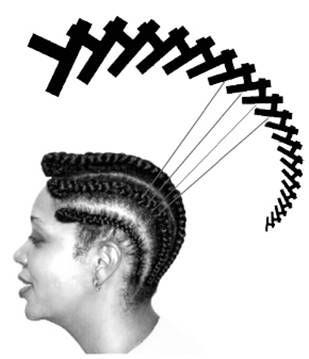Hair as Cosmos: Blackness, Beauty, and the Sacred Math of Fractals
The Infinite Language of Coils and Spirals: How Black Hair Reflects the Sacred Mathematics of the Universe.
The first time I understood the gravity of hair, I was sitting at my grandmother’s feet, head bowed, feeling the gentle but firm pull of her fingers parting my scalp into neat rows. The scent of coconut oil lingered in the air, mingling with the low murmur of soap operas playing in the background. This was more than grooming. This was ritual, geometry, an inherited knowledge passed down through fingers, through time. I didn’t have the words for it then, but what I now know is this: Black hair is a language, a pattern, a fractal repeating itself through generations.
Mathematician Benoît Mandelbrot coined the term "fractal" in 1975, describing self-similar patterns that exist at every scale in nature. Think of the branching of trees, the swirling arms of galaxies, the jagged edges of coastlines, forms that repeat themselves in endless variations, both vast and minuscule. But before Mandelbrot’s equations, before fractals had a name, Black hair had already been shaping itself into this rhythm, twisting and curling into a natural architecture that mirrors the universe itself.
For centuries, the geometry of Black hair has held meaning beyond aesthetics. Mathematician and ethnomathematician Ron Eglash, in African Fractals: Modern Computing and Indigenous Design, revealed that fractal thinking has long been embedded in African traditions. Villages in Mali, textiles in Ghana, beadwork among the Maasai, all reveal a deep mathematical consciousness, an intuitive understanding of recursion and self-similarity. The same principles appear in the intricate braiding patterns that have adorned Black heads for generations.
But hair is more than a mathematical marvel, it is a cultural archive. In my grandmother’s parlor, I watched women enter weary and leave transformed, their spirits lifted along with their edges. Hair was not simply arranged; it was sculpted into memory, woven with stories and laughter.
Cornrows, in particular, carry a layered history. During the transatlantic slave trade, enslaved Africans braided escape routes into their hair, encoding maps to freedom in the language of their curls. In Colombia, women carried grains of rice within their braids, preparing for the long journey ahead. Every plait was a line of resistance, a declaration that even under oppression, innovation would persist.
Even today, Black hair evolves with memory. The styles of our youth, the tight cornrows, the stiff press of a hot comb give way to the looser, freer coils of adulthood. Twist-outs unfurl like ocean waves, locs spiral like galaxies stretching toward infinity. Each stage of life brings a new relationship with hair, a quiet transformation that mirrors the passage of time.
To understand the fractals in Black hair is to recognize the way identity itself is layered, shifting, yet always connected to its origins. It is to see the universe not just in the sky or in the vastness of nature, but in the mirror, in the coils that spring from our scalps, in the hands that braid and unbraid our history. Black hair is a cosmos unto itself; a sacred mathematics, a living testament to the beauty of repetition, evolution, and infinite possibility.
Black Wonder is reader-supported—subscribe free or paid to keep the work alive.







I just started wearing my hair natural again. It’s a peaceful freeing thing.
How beautiful to discover you here Chenée, and to explore the depths and journeys of Black hair through your writing.